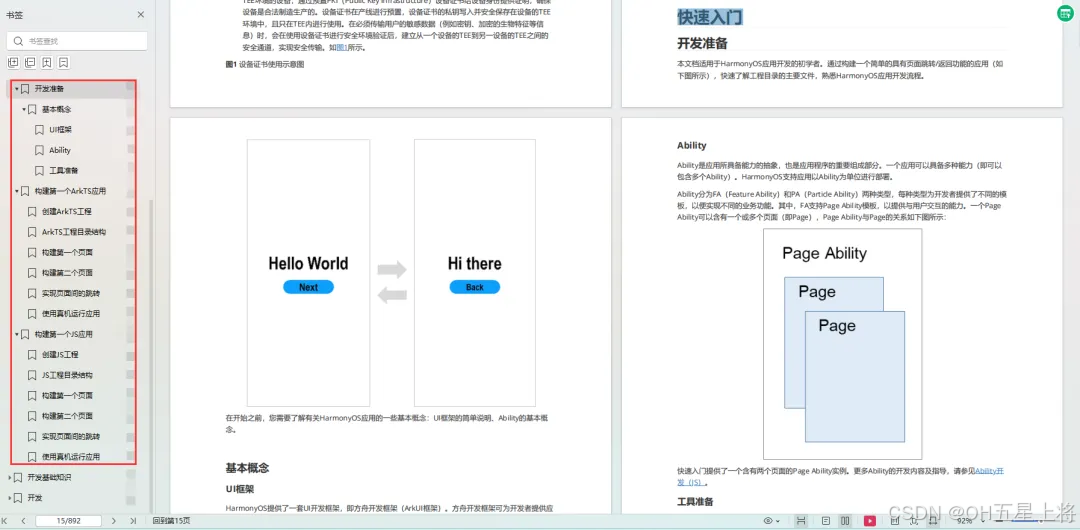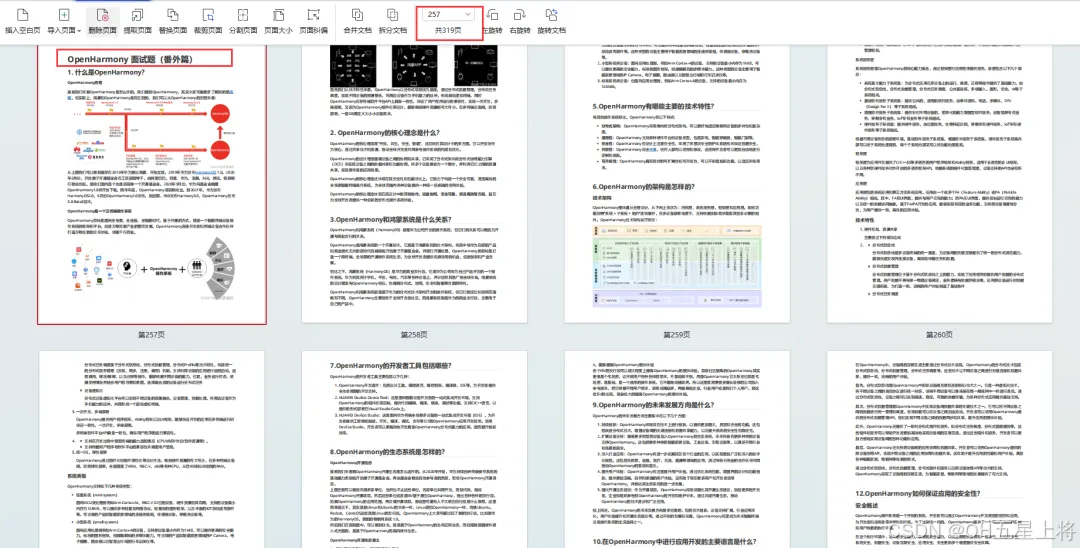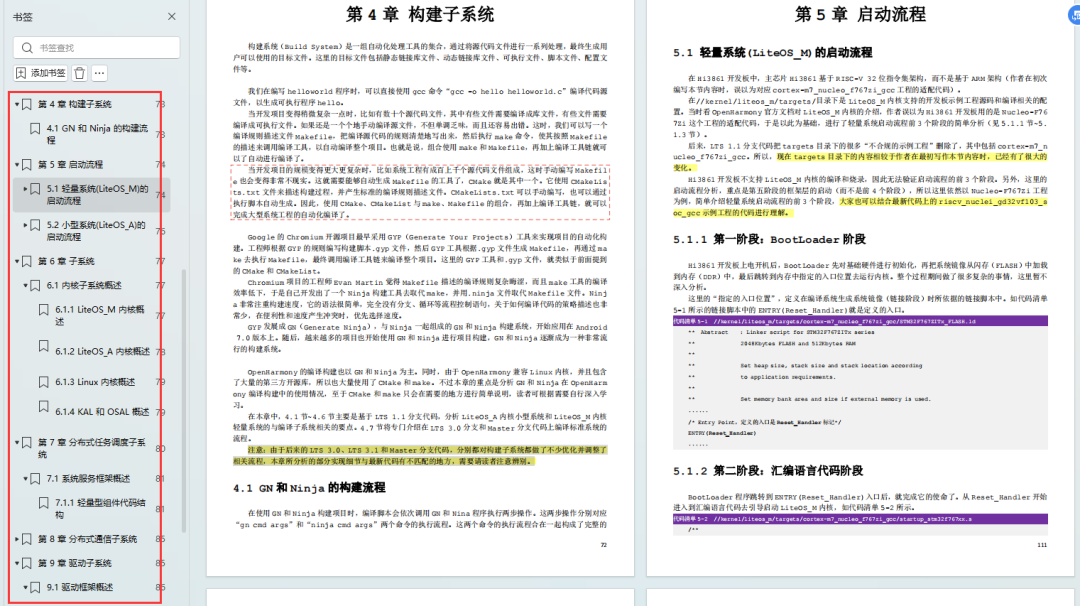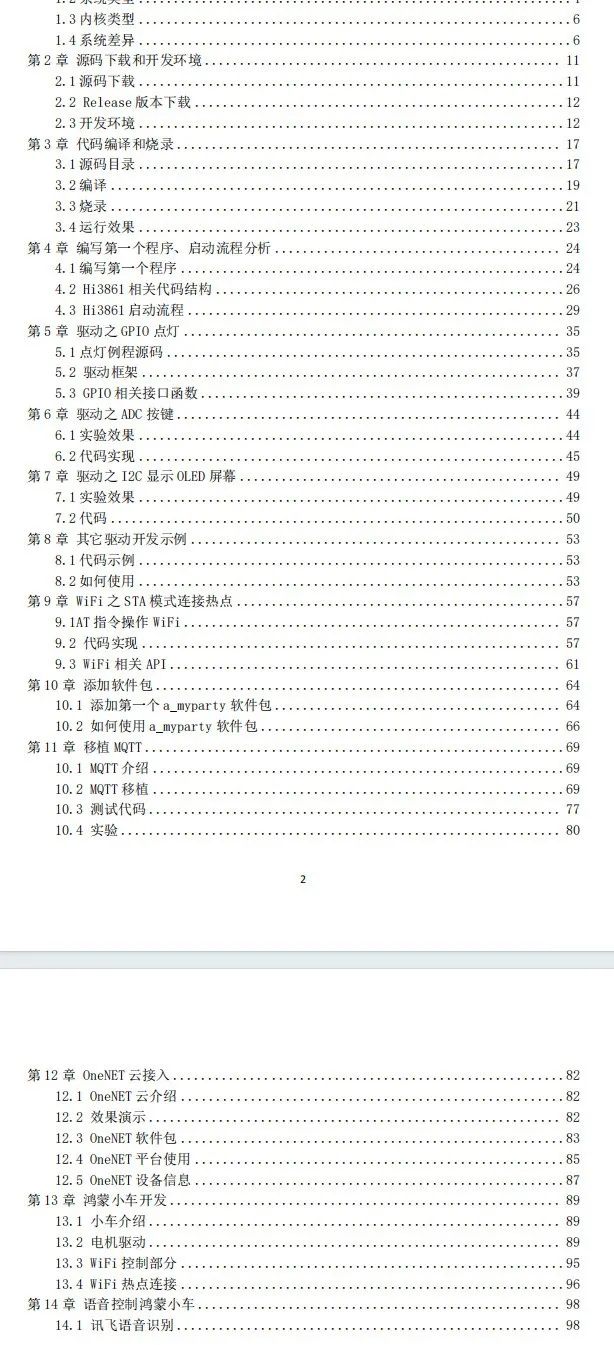【移植】Combo解决方案之W800芯片移植案例
往期知识点记录:
- 鸿蒙(HarmonyOS)应用层开发(北向)知识点汇总
- 鸿蒙(OpenHarmony)南向开发保姆级知识点汇总~
- 持续更新中……
本方案基于 OpenHarmony LiteOS-M 内核,使用联盛德 W800 芯片的润和软件海王星系列 Neptune100 开发板 ,进行开发移植。移植架构采用 Board 与 SoC 分离方案,支持通过 Kconfig 图形化配置编译选项,增加玄铁 ck804ef 架构移植,实现了 HDF、XTS 等子系统及组件的适配。
适配准备
准备 ubuntu20.04 系统环境,安装 csky-abiv2-elf-gcc 交叉编译工具链。
编译构建
目录规划
本方案的目录结构使用 Board 和 Soc 解耦的思路 :
芯片适配目录规划为:
device
├── board --- 单板厂商目录
│ └── hihope --- 单板厂商名字:HiHope
│ └── neptune100 --- 单板名:Neptune100
└── soc --- SoC厂商目录
└── winnermicro --- SoC厂商名字:联盛德
└── wm800 --- SoC Series名:w800系列芯片
产品样例目录规划为:
vendor
└── hihope --- 开发产品样例厂商目录,润和软件的产品样例
├── neptune_iotlink_demo --- 产品名字:Neptune100产品样例代码
└── ...
产品定义
vendor/hihope/neptune_iotlink_demo/config.json 文件下,描述了产品使用的内核、单板、子系统等信息。其中,内核、单板型号、单板厂商需提前规划好,是预编译指令 hb set 关注的。例如:
{
"product_name": "neptune_iotlink_demo", --- 产品名
"ohos_version": "OpenHarmony 3.1", --- 使用的OS版本
"type":"mini", --- 系统类型: mini
"version": "3.0", --- 系统版本: 3.0
"device_company": "hihope", --- 单板厂商:hihope
"board": "neptune100", --- 单板名:neptune100
"kernel_type": "liteos_m", --- 内核类型:liteos_m
"kernel_version": "3.0.0", --- 内核版本:3.0.0
"subsystems": [] --- 子系统
}
填入的信息与规划的目录相对应,其中 device_company 和 board 用于关联出 device/board/<device_company>/ 目录。
单板配置
关联到的 device/board/hihope/neptune100/liteos_m 目录下,在 device/board/hihope/neptune100/liteos_m 目录下放置 config.gni 文件,该配置文件用于描述该单板信息,包括 CPU 型号、交叉编译工具链及全局编译、链接参数等重要信息:
# Kernel type, e.g. "linux", "liteos_a", "liteos_m".
kernel_type = "liteos_m"
# Kernel version.
kernel_version = "3.0.0"
# Board CPU type, e.g. "cortex-a7", "riscv32".
board_cpu = "ck804ef"
# Board arch, e.g. "armv7-a", "rv32imac".
board_arch = "ck803"
# Toolchain name used for system compiling.
# E.g. gcc-arm-none-eabi, arm-linux-harmonyeabi-gcc, ohos-clang, riscv32-unknown-elf.
# Note: The default toolchain is "ohos-clang". It's not mandatory if you use the default toolchain.
board_toolchain = "csky-elfabiv2-gcc"
#use_board_toolchain = true
# The toolchain path installed, it's not mandatory if you have added toolchain path to your ~/.bashrc.
board_toolchain_path = ""
# Compiler prefix.
board_toolchain_prefix = "csky-elfabiv2-"
# Compiler type, "gcc" or "clang".
board_toolchain_type = "gcc"
# config.json parse
if (product_path != "") {
product_conf = read_file("${product_path}/config.json", "json")
product_name = product_conf.product_name
bin_list = product_conf.bin_list
}
# Board related common compile flags.
board_cflags = [
"-mcpu=ck804ef",
"-mhard-float",
"-DGCC_COMPILE=1",
"-DTLS_CONFIG_CPU_XT804=1",
"-DNIMBLE_FTR=1",
"-D__CSKY_V2__=1",
"-DCPU_CK804",
"-O2",
"-g3",
"-Wall",
"-ffunction-sections",
"-MMD",
"-MP",
]
board_cxx_flags = board_cflags
board_asmflags = [
"-mcpu=ck804ef",
"-DCPU_CK804",
]
board_ld_flags = []
# Board related headfiles search path.
board_include_dirs = []
# Board adapter dir for OHOS components.
board_adapter_dir = ""
# Sysroot path.
board_configed_sysroot = ""
# Board storage type, it used for file system generation.
storage_type = ""
预编译
在工程根目录下输入预编译指令 hb set 可显示相关产品信息,如下:
hb set
OHOS Which product do you need? (Use arrow keys)
hihope
> neptune_iotlink_demo
OHOS Which product do you need? neptune_iotlink_demo
执行 hb set 后,会在根目录下自动生成 ohos_config.json 文件,文件中会列出待编译的产品信息。
通过 hb env 可以查看选择出来的预编译环境变量。
[OHOS INFO] root path: /home/xxxx/openharmony_w800
[OHOS INFO] board: neptune100
[OHOS INFO] kernel: liteos_m
[OHOS INFO] product: neptune_iotlink_demo
[OHOS INFO] product path: /home/xxxx/openharmony_w800/vendor/hihope/neptune_iotlink_demo
[OHOS INFO] device path: /home/xxxx/openharmony_w800/device/board/hihope/neptune100/liteos_m
[OHOS INFO] device company: hihope
至此,预编译适配完成,但工程还不能执行 hb build 进行编译,还需要准备好后续的 LiteOS-M 内核移植。
内核移植
Kconfig 适配
在 kernel/liteos_m 的编译中,需要在相应的单板以及 SoC 目录下使用 Kconfig 文件进行索引。
-
在
vendor/hihope/neptune_iotlink_demo目录下创建 kernel_configs 目录,并创建debug.config空文件。 -
打开
kernel/liteos_m/Kconfig文件,可以看到在该文件通过 orsource 命令导入了device/board和device/soc下多个Kconfig文件,后续需要创建并修改这些文件:
orsource "../../device/board/*/Kconfig.liteos_m.shields"
orsource "../../device/board/$(BOARD_COMPANY)/Kconfig.liteos_m.defconfig.boards"
orsource "../../device/board/$(BOARD_COMPANY)/Kconfig.liteos_m.boards"
orsource "../../device/soc/*/Kconfig.liteos_m.defconfig"
orsource "../../device/soc/*/Kconfig.liteos_m.series"
orsource "../../device/soc/*/Kconfig.liteos_m.soc"
- 在
device/board/hihope下创建相应的的Kconfig文件:
├── neptune100 --- neptune100单板配置目录
│ ├── Kconfig.liteos_m.board --- 单板的配置选项
│ ├── Kconfig.liteos_m.defconfig.board --- 单板的默认配置项
│ └── liteos_m
│ └── config.gni --- 单板的配置文件
├── Kconfig.liteos_m.boards --- 单板厂商下Boards配置信息
└── Kconfig.liteos_m.defconfig.boards --- 单板厂商下Boards默认配置信息
- 修改
Board目录下Kconfig文件内容:
在neptune100/Kconfig.liteos_m.board中添加,
config BOARD_NEPTUNE100
bool "select board neptune100"
depends on SOC_WM800
配置只有 SOC_WM800 被选后,BOARD_NEPTUNE100 才可被选。
在 neptune100/Kconfig.liteos_m.defconfig.board 中添加,
if BOARD_NEPTUNE100
endif #BOARD_NEPTUNE100
用于添加 BOARD_NEPTUNE100 默认配置
- 在
device/soc/winnermicro下创建相应的的Kconfig文件:
├── wm800 --- W800系列
│ ├── Kconfig.liteos_m.defconfig.wm800 --- W800芯片默认配置
│ ├── Kconfig.liteos_m.defconfig.series --- W800系列默认配置
│ ├── Kconfig.liteos_m.series --- W800系列配置
│ └── Kconfig.liteos_m.soc --- W800芯片配置
├── Kconfig.liteos_m.defconfig --- SoC默认配置
├── Kconfig.liteos_m.series --- Series配置
└── Kconfig.liteos_m.soc --- SoC配置
- 修改
Soc目录下Kconfig文件内容:
在wm800/Kconfig.liteos_m.defconfig.wm800中添加:
config SOC
string
default "wm800"
depends on SOC_WM800
在 wm800/Kconfig.liteos_m.defconfig.series 中添加:
if SOC_SERIES_WM800
rsource "Kconfig.liteos_m.defconfig.wm800"
config SOC_SERIES
string
default "wm800"
endif
在 wm800/Kconfig.liteos_m.series 中添加:
config SOC_SERIES_WM800
bool "winnermicro 800 Series"
select ARM
select SOC_COMPANY_WINNERMICRO --- 选择 SOC_COMPANY_WINNERMICRO
select CPU_XT804
help
Enable support for winnermicro 800 series
在选择了 SOC_SERIES_WM800 之后,才可选 wm800/Kconfig.liteos_m.soc 文件中的 SOC_WM800:
choice
prompt "Winnermicro 800 series SoC"
depends on SOC_SERIES_WM800
config SOC_WM800 --- 选择 SOC_WM800
bool "SoC WM800"
endchoice
综上所述,要编译单板 BOARD_NEPTUNE100,则要分别选中:SOC_COMPANY_WINNERMICRO、SOC_SERIES_WM800、SOC_WM800
- 在
kernel/liteos_m中执行make menuconfig进行选择配置,能够对 SoC Series 进行选择:

配置后的文件会默认保存在 vendor/hihope/neptune_iotlink_demo/kernel_configs/debug.config,也可以直接填写 debug.config:
LOSCFG_PLATFORM_QEMU_CSKY_SMARTL=y
LOSCFG_SOC_SERIES_WM800=y
模块化编译
Board 和 SoC 的编译采用模块化的编译方法,从 kernel/liteos_m/BUILD.gn 开始逐级向下递增。本方案的适配过程如下:
- 在
device/board/hihope中新建文件BUILD.gn,新增内容如下:
if (ohos_kernel_type == "liteos_m") {
import("//kernel/liteos_m/liteos.gni")
module_name = get_path_info(rebase_path("."), "name")
module_group(module_name) {
modules = [
"neptune100", --- 单板模块
"shields",
]
}
}
在上述 BUILD.gn 中,neptune100 以及 shields 即是按目录层级组织的模块名。
- 在
device/soc/winnermicro中,新建文件BUILD.gn,按目录层级组织,新增内容如下:
if (ohos_kernel_type == "liteos_m") {
import("//kernel/liteos_m/liteos.gni")
module_name = get_path_info(rebase_path("."), "name")
module_group(module_name) {
modules = [
"hals",
"wm800",
]
}
}
- 在
device/soc/winnermicro各个层级模块下,同样新增文件BUILD.gn,将该层级模块加入编译。以device/soc/winnermicro/wm800/board/platform/sys/BUILD.gn为例:
import("//kernel/liteos_m/liteos.gni")
module_name = get_path_info(rebase_path("."), "name")
kernel_module(module_name) { --- 编译的模块
sources = [ --- 编译的源文件
"wm_main.c",
]
include_dirs = [ --- 模块内使用到的头文件
".",
]
}
- 为了组织链接以及一些编译选项,在
device/soc/winnermicro/wm800/board/BUILD.gn下的config("board_config")填入了相应的参数:
config("board_config") {
ldflags = [] --- 链接参数,包括ld文件
libs = [] --- 链接库
include_dirs = [] --- 公共头文件
- 为了组织一些产品侧的应用,需要强制链接到产品工程中来,本方案在 vendor 相应的
config.json加入了相应的 list 来组织,在vendor/hihope/neptune_iotlink_demo/config.json增加对应的 list:
"bin_list": [ --- demo list
{
"elf_name": "hihope",
"enable": "false", --- list开关
"force_link_libs": [
"bootstrap",
"broadcast",
...
]
}
将 demo 应用作为模块库来管理,开启/关闭某个 demo,在 bin_list 中增减相应库文件即可。bin_list 在 gn 中可以直接被读取,在 device/board/hihope/neptune100/liteos_m/config.gni 新增内容:
# config.json parse
if (product_path != "") {
product_conf = read_file("${product_path}/config.json", "json")
product_name = product_conf.product_name
bin_list = product_conf.bin_list
}
读取 list 后即可在相应的链接选项上加入相关的组件库,在 //device/soc/winnermicro/wm800/BUILD.gn 添加内容:
foreach(bin_file, bin_list) {
build_enable = bin_file.enable
...
if(build_enable == "true")
{
...
foreach(force_link_lib, bin_file.force_link_libs) {
ldflags += [ "-l${force_link_lib}" ]
}
...
}
}
内核子系统适配
在 vendor/hihope/neptune_iotlink_demo/config.json 添加内核子系统及相关配置,如下:
"subsystems": [
{
"subsystem": "kernel",
"components": [
{
"component": "liteos_m", "features":[]
}
]
},
内核启动适配
由于 Neptune100 开发板的芯片架构为 OpenHarmony 不支持的 ck804ef 架构,需要进行 ck804ef 架构移植。适配 kernel\liteos_m\arch\include 中定义的通用的文件以及函数列表,并放在了 kernel\liteos_m\arch\csky\v2\ck804\gcc 文件夹下。
内核初始化示例如下:
osStatus_t ret = osKernelInitialize(); --- 内核初始化
if(ret == osOK)
{
threadId = osThreadNew((osThreadFunc_t)sys_init,NULL,&g_main_task); --- 创建init线程
if(threadId!=NULL)
{
osKernelStart(); --- 线程调度
}
}
board_main 在启动 OHOS_SystemInit 之前,需要初始化必要的动作,如下:
...
UserMain(); --- 启动OpenHarmony OHOS_SystemInit的之前完成驱动的初始化
...
OHOS_SystemInit(); --- 启动OpenHarmony服务,以及组件初始化
...
UserMain 函数在 device/soc/winnermicro/wm800/board/app/main.c 文件中,如下:
...
if (DeviceManagerStart()) { --- HDF初始化
printf("[%s] No drivers need load by hdf manager!",__func__);
}
...
HDF 驱动框架适配
HDF 驱动框架提供了一套应用访问硬件的统一接口,可以简化应用开发,添加 HDF 组件需要在 //vendor/hihope/neptune_iotlink_demo/kernel_configs 添加:
LOSCFG_DRIVERS_HDF=y
LOSCFG_DRIVERS_HDF_PLATFORM=y
驱动适配相关文件放置在 drivers/adapter/platform 中,对应有 gpio,i2c,pwm,spi,uart,watchdog,都是通过 HDF 机制加载,本章节以 GPIO 和 UART 为例进行详细说明。
GPIO 适配
- 芯片驱动适配文件位于
drivers/adapter/platform目录,在 gpio 目录增加gpio_wm.c文件,在BUILD.gn文件中,描述了 W800 驱动的编译适配。如下:
...
if (defined(LOSCFG_SOC_COMPANY_WINNERMICRO)) {
sources += [ "gpio_wm.c" ]
}
...
gpio_wm.c中驱动描述文件如下:
/* HdfDriverEntry definitions */
struct HdfDriverEntry g_GpioDriverEntry = {
.moduleVersion = 1,
.moduleName = "WM_GPIO_MODULE_HDF",
.Bind = GpioDriverBind,
.Init = GpioDriverInit,
.Release = GpioDriverRelease,
};
HDF_INIT(g_GpioDriverEntry);
- 在
device/board/hihope/shields/neptune100/neptune100.hcs添加 gpio 硬件描述信息, 添加内容如下:
root {
platform {
gpio_config {
match_attr = "gpio_config";
groupNum = 1;
pinNum = 48;
}
}
}
- 在 GpioDriverInit 获取 hcs 参数进行初始化,如下:
...
gpioCntlr = GpioCntlrFromHdfDev(device); --- gpioCntlr节点变量获取具体gpio配置
if (gpioCntlr == NULL) {
HDF_LOGE("GpioCntlrFromHdfDev fail\r\n");
return HDF_DEV_ERR_NO_DEVICE_SERVICE;
}
...
UART 适配
- 芯片驱动适配文件位于
drivers/adapter/platform目录,在 uart 目录增加uart_wm.c文件,在BUILD.gn文件中,描述了 W800 驱动的编译适配。如下:
...
if (defined(LOSCFG_SOC_COMPANY_WINNERMICRO)) {
sources += [ "uart_wm.c" ]
}
...
uart_wm.c中驱动描述文件如下:
/* HdfDriverEntry definitions */
struct HdfDriverEntry g_UartDriverEntry = {
.moduleVersion = 1,
.moduleName = "W800_UART_MODULE_HDF",
.Bind = UartDriverBind,
.Init = UartDriverInit,
.Release = UartDriverRelease,
};
/* Initialize HdfDriverEntry */
HDF_INIT(g_UartDriverEntry);
- 在
device/board/hihope/shields/neptune100/neptune100.hcs添加 uart 硬件描述信息, 添加内容如下:
root {
platform {
uart_config {
/*
uart0 {
match_attr = "uart0_config";
num = 0;
baudrate = 115200;
parity = 0;
stopBit = 1;
data = 8;
}*/
uart1 {
match_attr = "uart1_config";
num = 1;
baudrate = 115200;
parity = 0;
stopBit = 1;
data = 8;
}
}
}
}
- 在 UartDriverInit 获取 hcs 参数进行初始化,如下:
...
host = UartHostFromDevice(device);
if (host == NULL) {
HDF_LOGE("%s: host is NULL", __func__);
return HDF_ERR_INVALID_OBJECT;
}
...
OpenHarmony 子系统适配
子系统的编译选项入口在相应产品 config.json 下,如:vendor/hihope/neptune_iotlink_demo/config.json。
wifi_lite 组件
首先,在 config.json 文件中,增加 communication 子系统的 wifi_lite 部件,如下:
{
"subsystem": "communication",
"components": [
{
"component": "wifi_lite",
"optional": "true"
}
]
},
wifi_lite 部件在 build/lite/components/communication.json 文件中,描述如下:
{
"component": "wifi_lite",
"targets": [
"//foundation/communication/wifi_lite:wifi" --- wifi_lite的编译目标
]
},
在本案例中,wifi 适配源码可见 device/soc/winnermicro/wm800/board/src/wifi/wm_wifi.c,如下:
int tls_wifi_netif_add_status_event(tls_wifi_netif_status_event_fn event_fn) ---用于增加wifi事件功能
{
u32 cpu_sr;
struct tls_wifi_netif_status_event *evt;
//if exist, remove from event list first.
tls_wifi_netif_remove_status_event(event_fn);
evt = tls_mem_alloc(sizeof(struct tls_wifi_netif_status_event));
if(evt==NULL)
return -1;
memset(evt, 0, sizeof(struct tls_wifi_netif_status_event));
evt->status_callback = event_fn;
cpu_sr = tls_os_set_critical();
dl_list_add_tail(&wifi_netif_status_event.list, &evt->list);
tls_os_release_critical(cpu_sr);
return 0;
}
系统服务管理子系统适配
系统服务管理子系统适配添加 samgr_lite 部件,直接在 config.json 配置,如下:
{
"subsystem": "systemabilitymgr",
"components": [
{
"component": "samgr_lite"
}
]
},
公共基础库子系统适配
公共基础库子系统适配添加了 kv_store、file 部件,直接在 config.json 配置,如下:
{
"subsystem": "utils",
"components": [
{
"component": "kv_store",
"features": [
"enable_ohos_utils_native_lite_kv_store_use_posix_kv_api = true"
]
},
{ "component": "file", "features":[] }
]
},
适配 kv_store 部件时,键值对会写到文件中。在轻量系统中,文件操作相关接口有 POSIX 接口与 HalFiles 接口这两套实现。
因为对接内核的文件系统,采用 POSIX 相关的接口,所以 features 需要增加 enable_ohos_utils_native_lite_kv_store_use_posix_kv_api = true。
启动恢复子系统适配
启动恢复子系统适配添加了 bootstrap_lite、syspara_lite 部件,直接在 config.json 配置,如下:
{
"subsystem": "startup",
"components": [
{
"component": "bootstrap_lite"
},
{
"component": "syspara_lite",
"features": [
"enable_ohos_startup_syspara_lite_use_posix_file_api = true",
"config_ohos_startup_syspara_lite_data_path = \"/data/\""
]
}
]
},
适配 bootstrap_lite 部件时,需要在链接脚本文件 device/soc/winnermicro/wm800/board/ld/w800/gcc_csky.ld 中手动新增如下段:
.zinitcall_array :
{
. = ALIGN(0x4) ;
PROVIDE_HIDDEN (__zinitcall_core_start = .);
KEEP (*(SORT(.zinitcall.core*)))
KEEP (*(.zinitcall.core*))
PROVIDE_HIDDEN (__zinitcall_core_end = .);
. = ALIGN(0x4) ;
PROVIDE_HIDDEN (__zinitcall_device_start = .);
KEEP (*(SORT(.zinitcall.device*)))
KEEP (*(.zinitcall.device*))
PROVIDE_HIDDEN (__zinitcall_device_end = .);
. = ALIGN(0x4) ;
PROVIDE_HIDDEN (__zinitcall_bsp_start = .);
KEEP (*(SORT(.zinitcall.bsp*)))
KEEP (*(.zinitcall.bsp*))
PROVIDE_HIDDEN (__zinitcall_bsp_end = .);
. = ALIGN(0x4) ;
PROVIDE_HIDDEN (__zinitcall_sys_service_start = .);
KEEP (*(SORT(.zinitcall.sys.service*)))
KEEP (*(.zinitcall.sys.service*))
PROVIDE_HIDDEN (__zinitcall_sys_service_end = .);
. = ALIGN(0x4) ;
PROVIDE_HIDDEN (__zinitcall_app_service_start = .);
KEEP (*(SORT(.zinitcall.app.service*)))
KEEP (*(.zinitcall.app.service*))
PROVIDE_HIDDEN (__zinitcall_app_service_end = .);
. = ALIGN(0x4) ;
PROVIDE_HIDDEN (__zinitcall_sys_feature_start = .);
KEEP (*(SORT(.zinitcall.sys.feature*)))
KEEP (*(.zinitcall.sys.feature*))
PROVIDE_HIDDEN (__zinitcall_sys_feature_end = .);
. = ALIGN(0x4) ;
PROVIDE_HIDDEN (__zinitcall_app_feature_start = .);
KEEP (*(SORT(.zinitcall.app.feature*)))
KEEP (*(.zinitcall.app.feature*))
PROVIDE_HIDDEN (__zinitcall_app_feature_end = .);
. = ALIGN(0x4) ;
PROVIDE_HIDDEN (__zinitcall_run_start = .);
KEEP (*(SORT(.zinitcall.run*)))
KEEP (*(.zinitcall.run*))
PROVIDE_HIDDEN (__zinitcall_run_end = .);
. = ALIGN(0x4) ;
PROVIDE_HIDDEN (__zinitcall_test_start = .);
KEEP (*(SORT(.zinitcall.test*)))
KEEP (*(.zinitcall.test*))
PROVIDE_HIDDEN (__zinitcall_test_end = .);
. = ALIGN(0x4) ;
PROVIDE_HIDDEN (__zinitcall_exit_start = .);
KEEP (*(SORT(.zinitcall.exit*)))
KEEP (*(.zinitcall.exit*))
PROVIDE_HIDDEN (__zinitcall_exit_end = .);
} > REGION_RODATA
需要新增上述段是因为 bootstrap_init 提供的对外接口,见 utils/native/lite/include/ohos_init.h 文件,采用的是灌段的形式,最终会保存到上述链接段中。主要的服务自动初始化宏如下表格所示:
| 接口名 | 描述 |
|---|---|
| SYS_SERVICE_INIT(func) | 标识核心系统服务的初始化启动入口 |
| SYS_FEATURE_INIT(func) | 标识核心系统功能的初始化启动入口 |
| APP_SERVICE_INIT(func) | 标识应用层服务的初始化启动入口 |
| APP_FEATURE_INIT(func) | 标识应用层功能的初始化启动入口 |
通过上面加载的组件编译出来的 lib 文件需要手动加入强制链接。
如在 vendor/hihope/neptune_iotlink_demo/config.json 中配置了 bootstrap_lite 部件
{
"subsystem": "startup",
"components": [
{
"component": "bootstrap_lite"
},
...
]
},
bootstrap_lite 部件会编译 base/startup/bootstrap_lite/services/source/bootstrap_service.c,该文件中,通过 SYS_SERVICE_INIT 将 Init 函数符号灌段到 __zinitcall_sys_service_start 和 __zinitcall_sys_service_end 中,由于 Init 函数是没有显式调用它,所以需要将它强制链接到最终的镜像。如下:
static void Init(void)
{
static Bootstrap bootstrap;
bootstrap.GetName = GetName;
bootstrap.Initialize = Initialize;
bootstrap.MessageHandle = MessageHandle;
bootstrap.GetTaskConfig = GetTaskConfig;
bootstrap.flag = FALSE;
SAMGR_GetInstance()->RegisterService((Service *)&bootstrap);
}
SYS_SERVICE_INIT(Init); --- 通过SYS启动即SYS_INIT启动就需要强制链接生成的lib
在 base/startup/bootstrap_lite/services/source/BUILD.gn 文件中,描述了在 out/neptune100/neptune_iotlink_demo/libs 生成 libbootstrap.a,如下:
static_library("bootstrap") {
sources = [
"bootstrap_service.c",
"system_init.c",
]
...
适配 syspara_lite 部件时,系统参数会最终写到文件中进行持久化保存。在轻量系统中,文件操作相关接口有 POSIX 接口与 HalFiles 接口这两套实现。
因为对接内核的文件系统,采用 POSIX 相关的接口,所以 features 字段中需要增加 enable_ohos_startup_syspara_lite_use_posix_file_api = true。
XTS 子系统适配
XTS 子系统的适配,直接在 config.json 中加入组件选项:
{
"subsystem": "xts",
"components": [
{
"component": "xts_acts",
"features":
[
"config_ohos_xts_acts_utils_lite_kv_store_data_path = \"/data\"",
"enable_ohos_test_xts_acts_use_thirdparty_lwip = true"
]
},
{ "component": "xts_tools", "features":[] }
]
}
另外,XTS 功能也使用了 list 来组织,在 config.json 文件中增减相应模块:
"bin_list": [
{
"enable": "true",
"force_link_libs": [
"module_ActsParameterTest",
"module_ActsBootstrapTest",
"module_ActsDfxFuncTest",
"module_ActsHieventLiteTest",
"module_ActsSamgrTest",
"module_ActsUtilsFileTest",
"module_ActsKvStoreTest",
"module_ActsWifiServiceTest"
]
}
],
其它组件的适配过程与官方以及其它厂商的过程类似,不再赘述。
最后
经常有很多小伙伴抱怨说:不知道学习鸿蒙开发哪些技术?不知道需要重点掌握哪些鸿蒙应用开发知识点?
为了能够帮助到大家能够有规划的学习,这里特别整理了一套纯血版鸿蒙(HarmonyOS Next)全栈开发技术的学习路线,包含了鸿蒙开发必掌握的核心知识要点,内容有(ArkTS、ArkUI开发组件、Stage模型、多端部署、分布式应用开发、WebGL、元服务、OpenHarmony多媒体技术、Napi组件、OpenHarmony内核、OpenHarmony驱动开发、系统定制移植等等)鸿蒙(HarmonyOS NEXT)技术知识点。

《鸿蒙 (Harmony OS)开发学习手册》(共计892页):https://gitcode.com/HarmonyOS_MN/733GH/overview
如何快速入门?
1.基本概念
2.构建第一个ArkTS应用
3.……

鸿蒙开发面试真题(含参考答案):

《OpenHarmony源码解析》:
- 搭建开发环境
- Windows 开发环境的搭建
- Ubuntu 开发环境搭建
- Linux 与 Windows 之间的文件共享
- ……
- 系统架构分析
- 构建子系统
- 启动流程
- 子系统
- 分布式任务调度子系统
- 分布式通信子系统
- 驱动子系统
- ……

OpenHarmony 设备开发学习手册:https://gitcode.com/HarmonyOS_MN/733GH/overview


